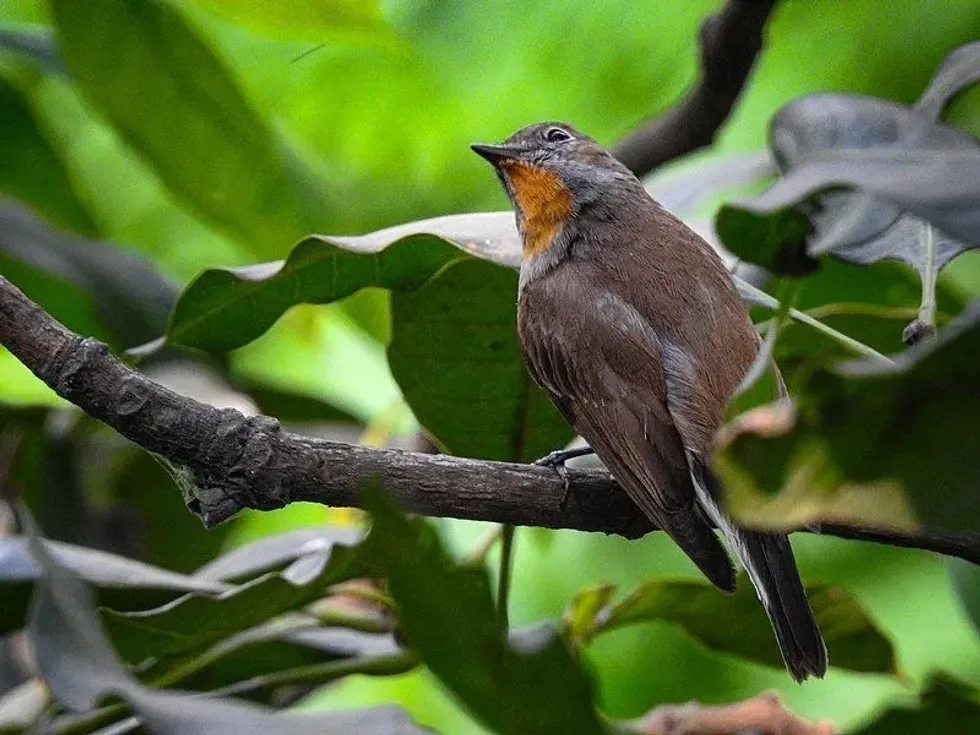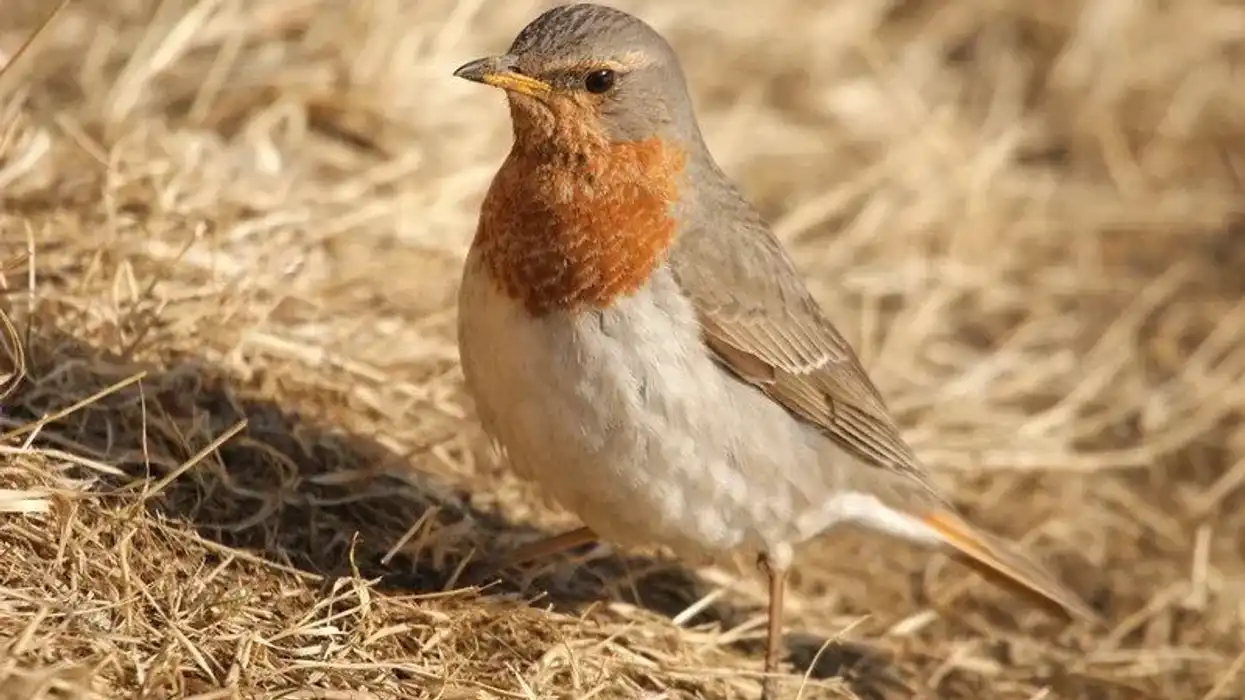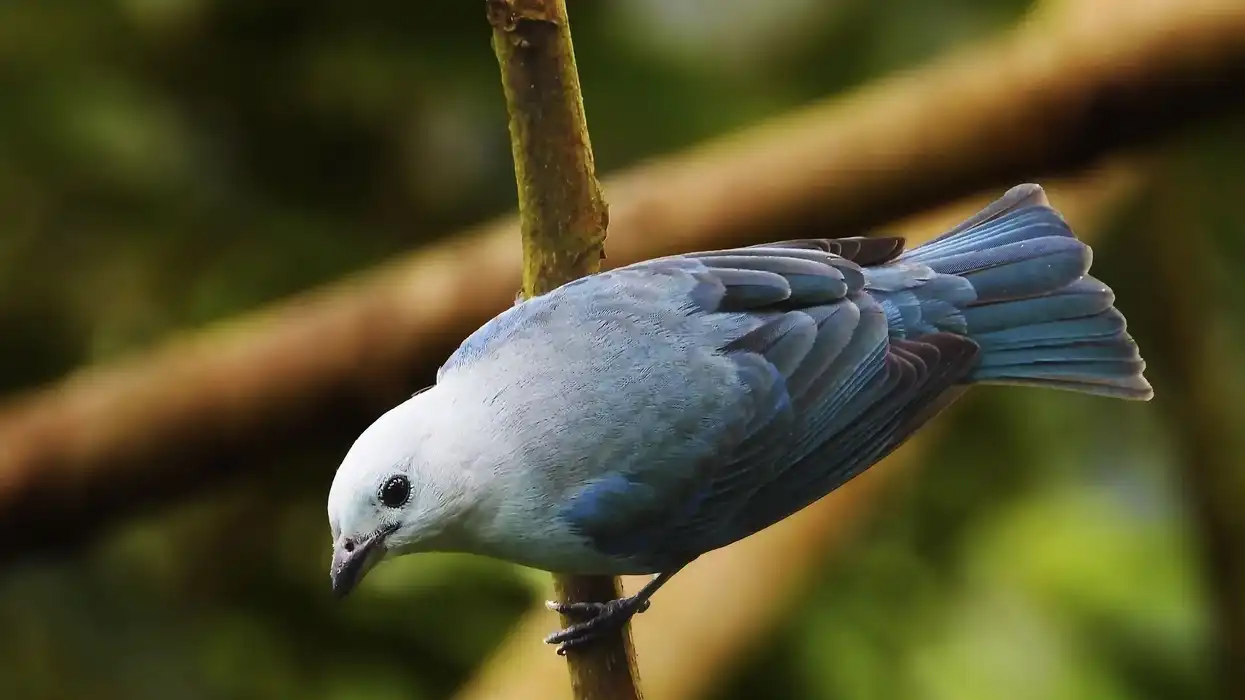Once considered a subspecies of the red breasted flycatcher, the Taiga flycatcher (red throated flycatcher) was first described in 1811 by a Prussian zoologist and a botanist named Peter Simon Pallas.
It is now a full species of its own and its scientific name is Ficedula albicilla. The specific verbiage albicilla is taken from the Latin word 'albus' meaning white (albus white), and New Latin word 'cilla', meaning tail.
It comes from the family Muscicapa, which also includes birds such as the brown breasted flycatcher and the scissor tailed flycatcher.
These birds are 4.33-5.12 in (11-13 cm) in length. It breeds from eastern Europe and across Central Asia. Known for being a winter visitor, it travels to South and Southeast Asia in Bangladesh, Bhutan, India, in addition to Cambodia, Laos, Myanmar, Nepal, Malaysia, Thailand, China, Vietnam, and Japan.
As the name denotes, its natural habitat is the 'Taiga' forest. It is also recognized as a rare vagrant in North America.
The genus name Ficedula is from Latin and refers to a small fig-eating bird (derived from Latin word 'Ficus', meaning fig; ficus fig). These birds are very well populated and are found in a huge range.
A non endemic, woodland bird that migrates long distances, the red throated flycatcher is nothing short of spectacular. Don't let these medium sized deceive you, these birds are well adept at dropping to the ground to capture prey.
Taiga Flycatcher Interesting Facts
What type of animal is a Taiga flycatcher?
It is a type of bird, part of the mammal family.
What class of animal does a Taiga flycatcher belong to?
It belongs to the class of Aves.
How many Taiga flycatchers are there in the world?
The exact number of birds of this species has not been recorded yet.
Where does a Taiga flycatcher live?
The Ficedula albicilla range from southeast Nepal to north India, Bangladesh, and southeast China. They are sometimes even found in western Europe.
What is a Taiga flycatcher's habitat?
These species are usually found in the mixed and deciduous forest of mountains which have dense undergrowth and tall trees.
Who do Taiga flycatchers live with?
The Taiga Flycatchers (Ficedula albicilla) usually tend to live on their own unless during the mating period where they live in pairs. They are very territorial birds like other species of the Muscicapidae family.
How long does a Taiga flycatcher live?
The exact lifespan of this species has not been recorded yet.
How do they reproduce?
The breeding period takes place from mid-June to August.
What is their conservation status?
These birds have a huge range and are well populated because of which the conservation status for this bird is evaluated as Least Concern.
Taiga Flycatcher Fun Facts
What do Taiga Flycatchers look like?
In breeding plumage, males have a brown to greyish-brown head and upperparts, but the upper-tail-coverts are darker, almost blackish. They have a dark bill with a dark tail with a white base. The underparts are white with a peach tinge.
It has an orange throat, bordered with grey. These birds look very similar to the red breasted flycatcher.
The only difference is that they are a little bigger in size in comparison to the red breasted flycatcher and the overall coloration of the red breasted flycatcher is brighter in appearance. The lores, malar area, and ear coverts are gray. The pointed bill is blackish with a yellowish tinge and it is variably dark towards the tip.
It has brown eyes with feathery white eyering. The legs and feet are dark brown to blackish.
In non breeding plumage, the male has reduced rufous-orange patch and its underparts become more buffish. The female resembles a male, but there is an absence of the red throat that the male possesses and hers is mostly white. The underparts are grayish buff.
The Taiga flycatcher (Ficedula albicilla) is similar in appearance to the red breasted flycatcher and was once considered its subspecies. it has a darker bill and black upper tail coverts, which is very different in the case of a red-breasted flycatcher.
These birds come from the family old world flycatchers which have a total of 324 species. The genus name for the bird is Ficedula which is a Latin word and refers to a small fig eating bird.
Taiga flycatcher's female upperparts are brown in color with the black tail flanked by white. Its breast is buffish with mostly whiteish underparts. Males have ear coverts.
The sides of the neck are blue tinged gray. Breeding males have orange red coloration on their throats.

How cute are they?
These small passerine birds are small and colored and are considered very cute.
How do they communicate?
They communicate with other birds through their song and by flicking their wings and tail when they feel threatened to scare the predator off.
How big is a Taiga flycatcher?
They are 4.33-5.12 in (11-13 cm) in length.
How fast can a Taiga flycatcher fly?
The exact speed of flight of this bird has not been recorded yet.
How much does a Taiga flycatcher weigh?
This flycatcher weighs around 0.49 0z (14g).
What are the male and female names of the species?
There is no sex specific name for the different sexes of the species.
What would you call a baby Taiga flycatcher?
A baby flycatcher of this species (Ficedula albicilla) is called a chick.
What do they eat?
They are insectivores.
Are they friendly?
Yes, these birds are friendly in nature.
Would they make a good pet?
No, these birds are migratory in nature and prefer to live in isolation. They would not make a good pet.
Did you know...
Only the female of the species builds nests. They are solitary nesters. These nests are cup shaped, made specifically in a hole in a tree or wall, a few meters above the ground. Males do not build nests.
These birds are monogamous, that is they have relationships with only one partner at a time, rather than multiple partners. All the more reason as to why they nest in isolated pairs. Males display the courtship to female by feeding her.
Although the cup shaped nest is built by the female some meters above the ground, it also accepts nest boxes.
What is the call of the Taiga glycatcher?
The sound produced is a soft rattling 'trrr' and less frequently, clicking 'tek' notes, and also a harsh 'zree' The song is melodious, high pitched and ends with 'zri zri zri chee chee dee-cha dee-cha dee-cha chu chu chu tu tu tu tu too taa'.
Do Taiga flycatchers migrate?
Yes, these are indeed migratory in nature, it migrates towards southern or southeast Asia during winter and is a rare vagrant in western Europe.
Here at Kidadl, we have carefully created lots of interesting family friendly animal facts for everyone to discover! For more relatable content, check out these great crested flycatcher, or vermilion flycatcher
You can even occupy yourself at home by coloring in one of our free printable Taiga flycatcher coloring pages.









